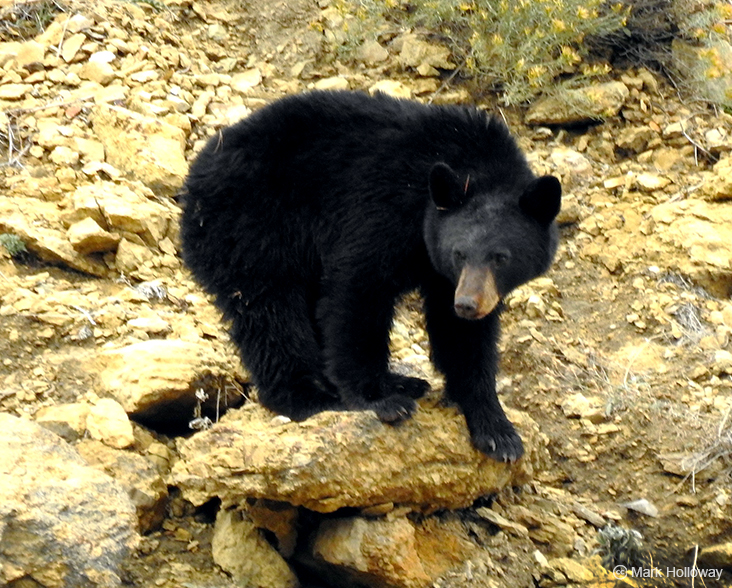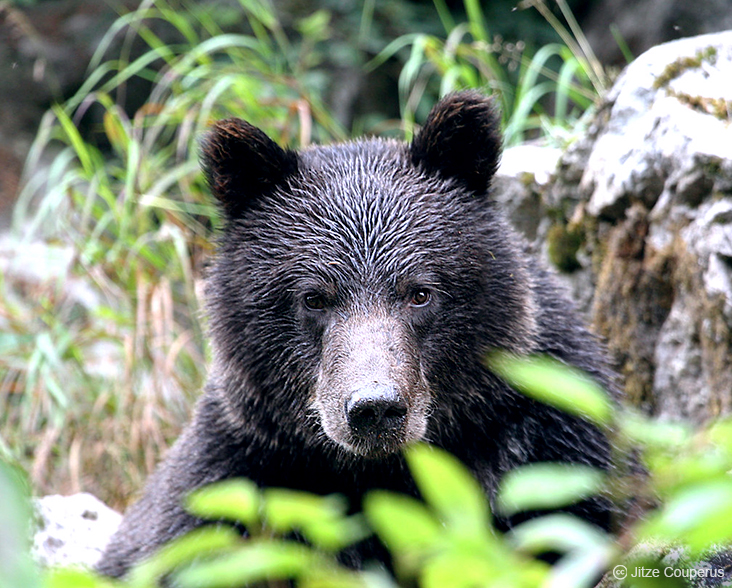Species Data
Class: Mammalia
Order: Carnivora
Family: Ursidae
Scientific Name: Ursus americanus
IUCN Red List status: Least concern
Description
American Black Bears are the most numerous of all bear species and can be found across North America, ranging as far south as central Mexico. Black bears are smaller than other North American bears, measuring 1.5-1.8 meters in length. Adult males can weigh up to 200 kilograms. The Black Bear can be distinguished from the Grizzly Bear (North American populations of the Brown Bear, Ursus arctos) by its shorter claws and lack of the characteristic shoulder “hump”, as well as by its smaller size.
The coat of Black Bears can be brown or dark red (with rare occurrences of other variations) as well as black, tending towards black in the North and East of their range and brown in the South and West. Although classified as a carnivore, Black Bears are opportunistic feeders, mainly eating plant matter.
Behaviour
Black Bears are usually solitary, but will tolerate the presence of others if food is ample. In common with other bear species, they will mark trees with teeth or claws to indicate their territory.
Black Bears spend most of their waking lives searching for food. They have excellent senses of smell and hearing, and will hunt small deer, eat carrion or catch fish to supplement their main diet of foraged vegetation, fruit and nuts. Black bears have few natural predators due to their size, save for the larger Grizzly Bear. They are agile climbers and will seek to escape danger in the branches of trees.
Black Bears are found in a variety of different climates, with behaviour varying depending on the local conditions. They will hibernate for up to eight months at the northernmost latitudes of their range, while bears living in warmer climates at the southern extent may not hibernate at all (with the exception of pregnant females).
The gestation period for the species is around seven months, after which the female will give birth in a den, producing between one and five cubs. The cubs are highly vulnerable in their first months and are wholly dependent on their mother. They will stay with her for up to two years.


Habitat
American Black Bears are found in pockets across North America, with the exception of the central plains of the USA. Their range has contracted due to human activity, but nonetheless this adaptable species can be found throughout much of the continent. They live in a variety of forest habitats, including coniferous Canadian forests, humid woodlands in the south eastern USA and dry woodland in Mexico, and will adapt to other environments.
Encroachment on their habitat has resulted in cases of bears scavenging in developed areas and increased encounters with humans.
The return of the Black bear to Central Mexico was recently confirmed in Sierra Gorda during a trail camera survey.
Threats and Conservation
The American Black Bear is classified by the IUCN as being a species of Least Concern in terms of risk of extinction, although some sub-species (including Ursus americanus luteolusand Ursus americanus floridanus) have been considered for protection as endangered species.
Despite hunting and encounters with humans caused by its foraging habits, the overall population of Black Bears is thought to be rising in North America. It is one of only two bear species not considered to be threatened with extinction (the other being the Brown Bear).
Black Bears are usually non aggressive and are tolerant of human presence. Where the Black Bear is threatened by human activity, it is typically due to hunting and destruction of its forest habitat.
